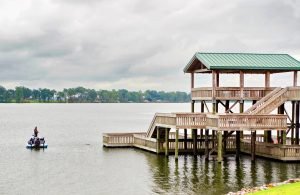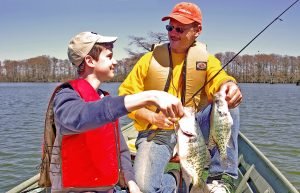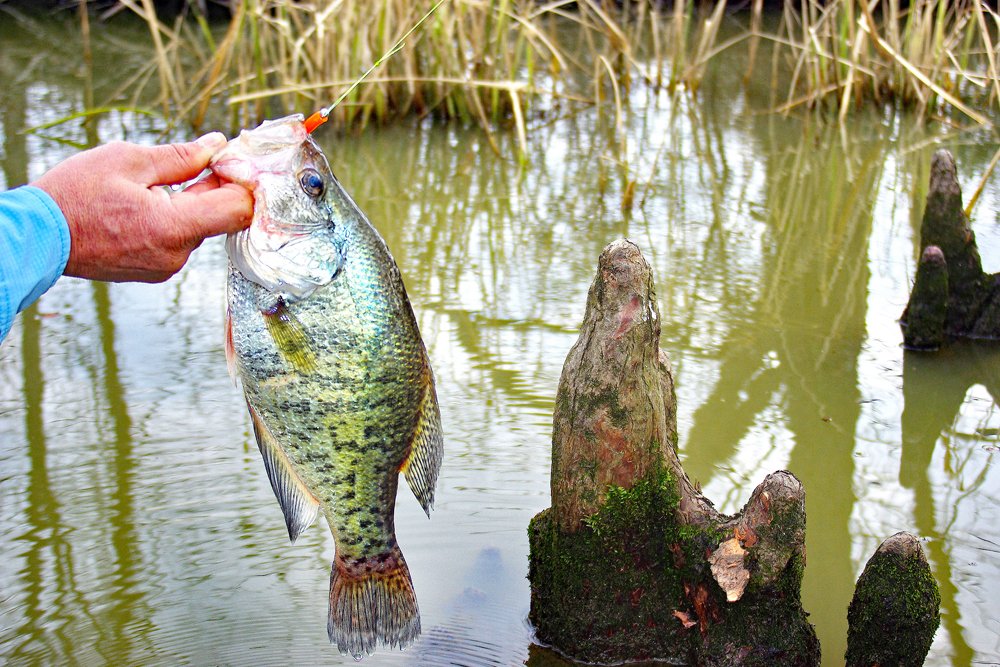Savvy oxbow anglers fish jigs and minnows around cypress knees and
buttresses to coax bites from their quarry. (Photo: Keith Sutton)
Fishing the Oxbows
by Keith Sutton
Fast-paced fishing for heavyweight crappie, beautiful scenery, easy access, a get-away-from-it-all atmosphere: these are some of the things crappie anglers look for when seeking a first-rate fishing spot. They are also the drawing cards to the Mississippi River oxbow lakes in Arkansas, as well as in many other states. Oxbows represent some of America’s finest, yet most often overlooked, crappie-fishing waters.
In Arkansas these natural lakes are sprinkled like emeralds along the Mississippi’s western bank. Over the eons, the big river eroded the outer banks of its broad bends, and curves have been severed as the stream changed course. The arcs of water left behind are known as oxbows because they resemble the wooden bows on ox yokes.
Fertile water with plentiful cover and abundant forage creates ideal crappie habitat. Anglers catch lots of these popular panfish, including plenty of trophy-class fish, and along the Natural State’s portion of the Mississippi. Here are some specific lakes you should consider fishing.
Horseshoe Lake
This 2,200-acre oxbow sits at the southern end of Crittenden County, eight miles east of Hughes, Ark. A spring visit will find visitors’ vehicles lined up at the boat ramps, with dozens of panfish poles sticking out the windows. Everywhere on the water, there are boats.

Anglers fishing around shallow cypress trees often reach their limits first. But others who drop jigs or minnows around boat docks, downed timber and underwater brushpiles rarely have trouble catching ice chests full of filleting-size crappie.
Toward evening, and as you watch long stringers and heavy coolers being lugged ashore, you might wonder if Horseshoe’s crappie are threatened by overharvest. Return the next day and the next, however, and that question will be shrugged off as ridiculous. The lake’s crappie population is enormous—among the healthiest in the Mid-South. That’s why you can keep 50 crappie daily here instead of the 30-fish creel limit on most other Arkansas waters.
The Arkansas Game & Fish Commission (AGFC) provides a free boat ramp on the lake’s west side. From Hughes, take Highway 38 East for seven miles. Then, turn right onto Highway 147 South. The boat ramp is one mile down on the left. You can find additional info on the AGFC website.
Midway Lake
If you’re looking for a more secluded oxbow teeming with oversized crappie, Midway Lake should be your next stop. This 1,000-acre oxbow is just a few miles southwest of Horseshoe near the town of Brickeys in Lee County. Cypress trees, buckbrush and willows line the shores, and big crappie are plentiful, including occasional fish weighing 2-1/2 to 3 pounds.
Prime crappie areas include the Big Killdee and Little Killdee (two buckbrush-covered points on the east side), stands of cypress trees near the south end and the deep-water run passing through open water in the lake’s midsection. Fishing is excellent year-round, but working the shallows during the spring spawn in April and May is the best way to put a limit of eaters in a cooler.
Locals like to fish 1/64- to 1/16-ounce tube or marabou jigs around shoreline cover this season, working each lure within the thickest tangles. This can result in lots of snags and lost fish, but Midway’s big crappie don’t reach “barn door” size by hanging around where every ol’ Joe fishes. You have to present your offerings in the densest cover available to nab the heavyweights.
For an up-to-date fishing report and additional information, contact Midway Lake Fish Camp, which has a bait store, boat launch, camping and RV hookups. Their facility is at 1 Lee Road 630, Brickeys, AR 72320; phone (870) 243-7552.
Old Town Lake
Continuing downstream along the Mississippi, we come to our next crappie-filled oxbow—Old Town Lake, 19 miles southwest of Helena-West Helena. A levee separates the 1,425-acre oxbow from its parent stream, resulting in stable water levels most of the year—a real advantage for crappie fans. The lake borders the town of Lakeview on Arkansas Highway 44 in Phillips County.

Old Town offers excellent spring fishing. It’s not uncommon to catch a 30-fish limit of crappie weighing 40 pounds or more this season, with most caught on minnows and jigs fished around the lake’s many cypress trees. Yo-yo fishing—using an automatic reel that triggers a hookset when a fish bites—is especially popular here, thanks to the abundance of low-hanging cypress limbs where fishermen can tie their rigs.
When crappie move up to spawn, savvy anglers regularly fish shallow backwaters along Old Town’s southeast side. Big galleries of cypress trees tower over the water there, and you can use a trolling motor or paddle to reach spawning beds in water six to 12 inches deep. A minnow or jig fished beneath a bobber on ultralight tackle will draw strikes from protective fish, but in some spots, you may need to don some waders and get in the water to reach them.
Don’t have a boat? No problem. Old Town also has a huge public fishing pier at the boat ramp in Lakeview. Fishing a minnow or jig beneath a bobber on the deepest side often produces scads of nice crappie. A map and additional info are on the AGFC website.
Lake Chicot
Lake Chicot in southeast Arkansas is the country’s largest oxbow lake. This 5,300-acre, 20-mile-long gem was a popular gathering place for turn-of-the-century anglers who came to enjoy the lake’s matchless sport fishing. But as its watershed was cleared for farming, Chicot grew muddy and polluted from agricultural runoff. By the 1940s, only rough fish like gar inhabited the lake.
That’s all changed today. A massive pumping plant diverts muddy drainage water to the Mississippi River, and the lake is clean again, a blue-ribbon destination for angling adventure.
Slab crappie attract numerous anglers to the quaint town of Lake Village on Chicot’s western shore. On productive days, many folks will quickly catch a 30-fish limit, especially those using silver tinsel-bodied jigs, Road Runners and small shad-imitation crankbaits that resemble local forage like shad, silversides and minnows. Crappie weighing 1 to 2 pounds are common.
There are no sharp variations in Chicot’s bowl-shaped bottom, so the best fishing tends to be around the outside (deeper water) edges of cypress trees, willows, buckbrush, dead timber and the lake’s numerous private docks. Some of the best crappie fishing is in the Connerly Bayou area where there are creek conditions with lots of good cover. Most anglers fish around willows and cypress trees, but Connerly has lots of deep brushy tops that also hold big slabs.
A marina at Lake Chicot State Park offers boat and motor rentals, fuel, bait and a launch ramp. The park also has campsites and cabins. An excellent map of the lake can be found on the AGFC website.
Final Thoughts
Arkansas’ Mississippi River oxbow lakes offer some of the best crappie fishing opportunities in the region. Whether you prefer jigging around cypress trees, drifting in deep water or setting yo-yos at dusk, these lakes provide a variety of ways to catch slabs. With their rich fishing history, beautiful surroundings and plentiful crappie populations, they are must-visit destinations for any serious crappie angler.
Keith Sutton is editor of our sister magazine at CatfishNOW.com. He’s been an avid crappie angler for more than half a century, pursuing his favorite panfish on waters throughout the United States. His fishing stories have been read by millions in hundreds of books, magazines, newspapers and Internet publications. In 2021, he was inducted into the Legends of the Outdoors Hall of Fame.


